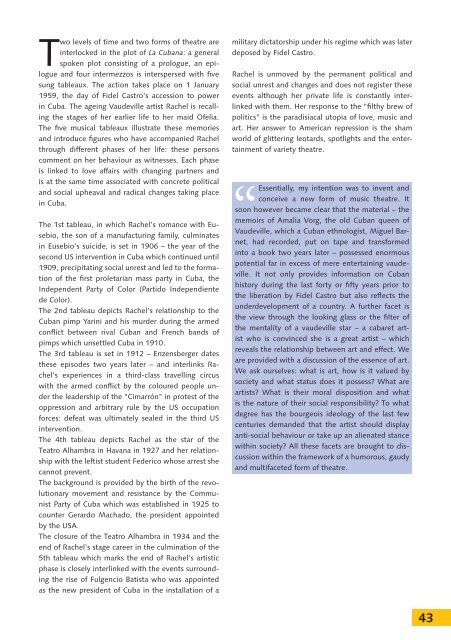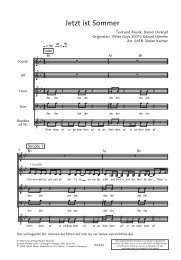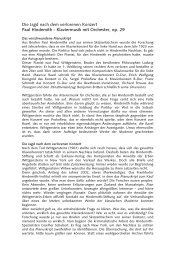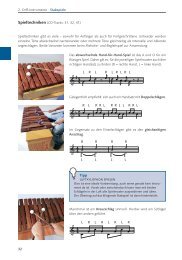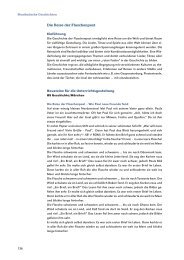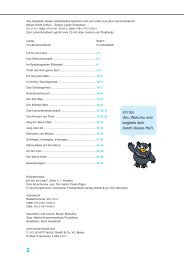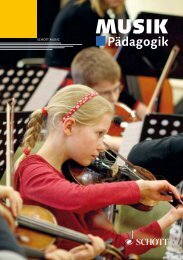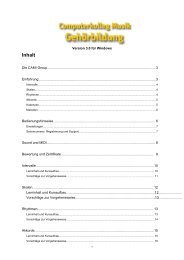HANS WERNER HENZE - Schott Music
HANS WERNER HENZE - Schott Music
HANS WERNER HENZE - Schott Music
Sie wollen auch ein ePaper? Erhöhen Sie die Reichweite Ihrer Titel.
YUMPU macht aus Druck-PDFs automatisch weboptimierte ePaper, die Google liebt.
Two levels of time and two forms of theatre are<br />
interlocked in the plot of La Cubana: a general<br />
spoken plot consisting of a prologue, an epilogue<br />
and four intermezzos is interspersed with five<br />
sung tableaux. The action takes place on 1 January<br />
1959, the day of Fidel Castro’s accession to power<br />
in Cuba. The ageing Vaudeville artist Rachel is recalling<br />
the stages of her earlier life to her maid Ofelia.<br />
The five musical tableaux illustrate these memories<br />
and introduce figures who have accompanied Rachel<br />
through different phases of her life: these persons<br />
comment on her behaviour as witnesses. Each phase<br />
is linked to love affairs with changing partners and<br />
is at the same time associated with concrete political<br />
and social upheaval and radical changes taking place<br />
in Cuba.<br />
The 1st tableau, in which Rachel’s romance with Eusebio,<br />
the son of a manufacturing family, culminates<br />
in Eusebio’s suicide, is set in 1906 – the year of the<br />
second US intervention in Cuba which continued until<br />
1909, precipitating social unrest and led to the formation<br />
of the first proletarian mass party in Cuba, the<br />
Independent Party of Color (Partido Independiente<br />
de Color).<br />
The 2nd tableau depicts Rachel’s relationship to the<br />
Cuban pimp Yarini and his murder during the armed<br />
conflict between rival Cuban and French bands of<br />
pimps which unsettled Cuba in 1910.<br />
The 3rd tableau is set in 1912 – Enzensberger dates<br />
these episodes two years later – and interlinks Rachel’s<br />
experiences in a third-class travelling circus<br />
with the armed conflict by the coloured people under<br />
the leadership of the “Cimarrón” in protest of the<br />
oppression and arbitrary rule by the US occupation<br />
forces: defeat was ultimately sealed in the third US<br />
intervention.<br />
The 4th tableau depicts Rachel as the star of the<br />
Teatro Alhambra in Havana in 1927 and her relationship<br />
with the leftist student Federico whose arrest she<br />
cannot prevent.<br />
The background is provided by the birth of the revolutionary<br />
movement and resistance by the Communist<br />
Party of Cuba which was established in 1925 to<br />
counter Gerardo Machado, the president appointed<br />
by the USA.<br />
The closure of the Teatro Alhambra in 1934 and the<br />
end of Rachel’s stage career in the culmination of the<br />
5th tableau which marks the end of Rachel’s artistic<br />
phase is closely interlinked with the events surrounding<br />
the rise of Fulgencio Batista who was appointed<br />
as the new president of Cuba in the installation of a<br />
military dictatorship under his regime which was later<br />
deposed by Fidel Castro.<br />
Rachel is unmoved by the permanent political and<br />
social unrest and changes and does not register these<br />
events although her private life is constantly interlinked<br />
with them. Her response to the “filthy brew of<br />
politics” is the paradisiacal utopia of love, music and<br />
art. Her answer to American repression is the sham<br />
world of glittering leotards, spotlights and the entertainment<br />
of variety theatre.<br />
“<br />
Essentially, my intention was to invent and<br />
conceive a new form of music theatre. It<br />
soon however became clear that the material – the<br />
memoirs of Amalia Vorg, the old Cuban queen of<br />
Vaudeville, which a Cuban ethnologist, Miguel Barnet,<br />
had recorded, put on tape and transformed<br />
into a book two years later – possessed enormous<br />
potential far in excess of mere entertaining vaudeville.<br />
It not only provides information on Cuban<br />
history during the last forty or fifty years prior to<br />
the liberation by Fidel Castro but also reflects the<br />
underdevelopment of a country. A further facet is<br />
the view through the looking glass or the filter of<br />
the mentality of a vaudeville star – a cabaret artist<br />
who is convinced she is a great artist – which<br />
reveals the relationship between art and effect. We<br />
are provided with a discussion of the essence of art.<br />
We ask ourselves: what is art, how is it valued by<br />
society and what status does it possess? What are<br />
artists? What is their moral disposition and what<br />
is the nature of their social responsibility? To what<br />
degree has the bourgeois ideology of the last few<br />
centuries demanded that the artist should display<br />
anti-social behaviour or take up an alienated stance<br />
within society? All these facets are brought to discussion<br />
within the framework of a humorous, gaudy<br />
and multifaceted form of theatre.<br />
43


